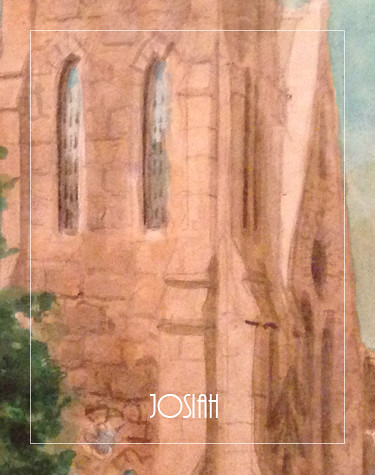
Volume XVI, Issue XXIV
Josiah
By Bob Kirchman
Copyright © 2019, The Kirchman Studio, all rights reserved
Chapter 11: Taking in Confidence
Ben-Gurion was wrestling. In the end he decided to take young Zimmerman into his confidence. Though the events on Mars were at the moment shrouded in secrecy, it would soon enough be time to let relatives of those who had survived know the fate of their loved ones.
He began, “Do you remember the Mars Mission before you were born? I was the pilot.”
Yes, a sad one, to be sure. No one survived on the planet’s surface. It must be painful for you to remember.”
Abiyah leaned closer, “We just sent an unmanned ship to the colony. There were survivors and we’ve been in conversation with them!”
The young man gasped.
Survivors – but HOW?!”
Ben-Gurion related the events that had transpired over the last year. He described the condition of the colony and the quandary it presented. “You see,” the professor concluded, “they see themselves, wretched as their lives are, as quite severed from Earth.”
So, am I to understand,” said Josiah, “that they have just enough technology to consider themselves self-sustaining, though they lack for so much we would consider basic essentials?”
Exactly, and MY quandary is what do we do next. They’re always on the verge of killing each other yet they fear us back on Earth more. APOLLONIUS taught them well, but he left out the most important lessons. They could stand to read Moses! Even though he killed the Egyptian, he thought better of it.”
Abiyah continued, “I am wrestling, my young friend – wrestling with making of you a most unusual request. Jon Greene and I are aware of your unique – gift, and your quandary as to how to use it. Obviously it would make more sense for ME to go to Mars, but I am a man of family. The other astronauts are largely technicians. They love their job. They man the defense platforms and in practice they get to blow stuff up, but they communicate in monotonous bursts. I am thinking we need someone gifted to ‘build the bridge,’ as it were.”
In Shalom, the Biosphere community on Big Diomede, as in the whole Zimmerman Organization, ‘Building the Bridge’ carried great meaning. It was a term not spoken lightly.
(to be continued)
Sacajawea's Story in Sculpture
Lemhi Shoshone Woman Guided Lewis and Clark

Sacajawea in Charlottesville's Lewis and Clark Statue...
A Milestone Monday Feature:
She was the wife of Toussaint Charbonneau, a Quebec trapper, and pregnant with her first child when she and her husband were hired to guide the Corps of Discovery. She would travel with them from present-day North Dakota to the Pacific Ocean. On the journey she would travel to the land of her birth, where she had been captured as a child. Her fluency in the languages and knowledge of the area's people not only led to the success of the expedition, Sacajawea can rightly be credited with their very survival.
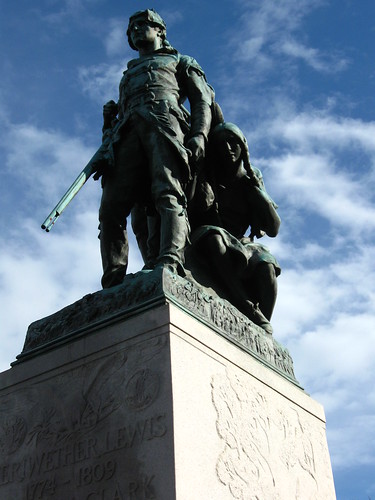
...is placed crouched behind the two white explorers, though she likely was in front of them most of the journey. The sculpture was created by Charles Keck in 1919. Photos by Bob Kirchman

This 1910 sculpture by Leonard Crunelle at the North Dakota State Capitol shows Sacagawea and her child Jean-Baptiste. Photo by Hans Anderson.
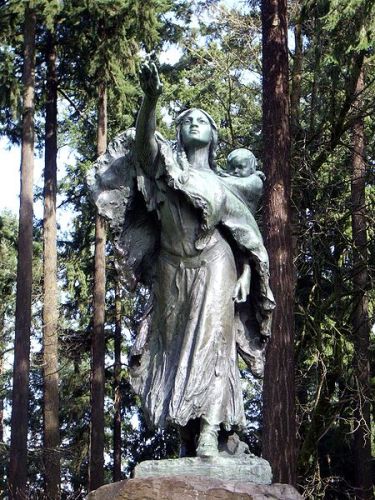
My favorite rendering of Sacajawea has to be this 1905 sculpture by Alice Cooper in Portland, Oregon's Washington Park. Photo by EncMstr.
In Portland, Oregon’s Washington Park there stands a statue of Sacajawea carrying her son, Jean-Baptiste Charbonneau. The sculpture was commissioned for the Lewis and Clark Centennial Exposition (1905) by the Committee of Portland Women, who requested a sculpture of “the only woman in the Lewis and Clark Expedition and in honor of the pioneer mother of old Oregon.” The sculpture was dedicated on July 6, 1905 and originally stood in the center of the exposition's plaza. Present at the dedication were prominent suffragettes: Susan B. Anthony, Abigail Scott Duniway and Anna Howard Shaw. The artist was Alice Cooper (April 8, 1875 – March 4, 1937), who was the first female artist to be represented in Portland's public sculpture collection.

Alice Cooper's sculpture of Sacajawea and Jean-Baptiste at the Lewis and Clark Centennial Exposition. OSU Special Collections.
Valley Railroad Bridge
Library of Congress Photos

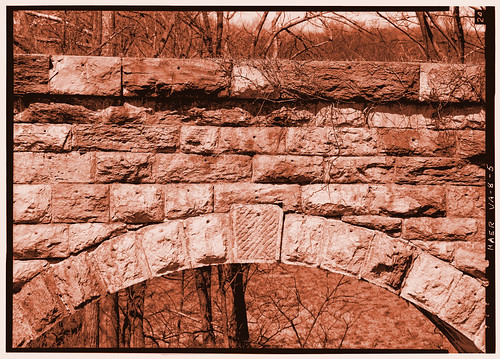


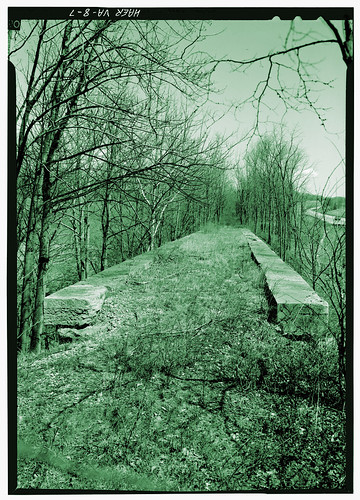

The Valley Railroad Stone Bridge, built in 1874, crosses Folly Mills Creek just west of Interstate Highway 81 approximately five miles south of Staunton. The bridge is a four-span structure with an over-all length of 130 feet and a width of 15 feet, It utilizes semi-circular arches set on gently splayed piers. Slightly projecting imposts are located between the tops of the piers and the spring of the arches. Granite is used throughout as the construction material, and the facing is a rough-surface ashlar. The only change to have occurred to the bridge is the removal of the railroad ties and rails. Because of the close proximity to Interstate 81, the bridge has become a familiar landmark to travelers throughout the Valley of Virginia. The Department of Highways maintains it as part of the highway's landscaping. National Register of Historic Places.
Rose and Lilies in Our Garden
Photos by Bob Kirchman

I am the rose of Sharon, and the lily of the valleys. As the lily among thorns, so is my love among the daughters. As the apple tree among the trees of the wood, so is my beloved among the sons.” – Song of Solomon 2:1-3


Nurture and Young Imagination
By Bob Kirchman
Imagine if schools actually helped kids identify their strengths by exploring their talents from a young age and growing their skills over the 12 years instead of letting them all follow the same routine like sheep and leaving them confused after graduation.” – Tallie Dar
I’m thinking about a wonderful illustration my supervisor at the homeschool coop, Amanda Riley gave to the students. She brought a box into the room and challenged all the students (about 17 individuals) to get into the box – all at once! The result was a bit of organized chaos that proved conclusively that all the students could NOT fit into the box! She then proceeded to underscore the uniqueness of each of our beautiful students. IMAGO DEI carries with it the same wonder that you find in a handmade piece of fine pottery. No two of them are EVER actually the same.
Yes, our job as educators is to provide a platform of basic grammar to facilitate our mutual growth and interaction, but I’m now convinced that we too often fail to observe – to see what our students are emerging to be as Divine works. I’m reading the Novel Mink River by Brian Doyle. Of particular interest to me is the sculptor Nora who takes a block of wood or stone and listens as she begins to chip away to see what it wants to be. So often we here the ‘malleable clay’ illustration applied to students and they are more like Nora’s wood or stone. We begin with the chisel and hammer, but even in the noise of chipping we must listen! My mother once took me to visit a friend of hers who was a sculptor. Somewhere in that conversation I think the old saw about “carving an elephant” came up in the conversation: “You cut away everything that doesn’t look like an elephant.” Actually that is not how great sculptors work, for they are looking for the elephant that is saying that it is in there!
My eyes scan our room full of unique works in progress. The future healers and builders and poets and prophets interact with the medium and hints emerge as to what the Divine is shaping there. They will go out from here and continue this process. Can what we do here serve to help them identify the grain and composition that they have been made with – and out of it shape a life pleasing to their maker?
I think of my own childhood. At five, I think I remember mom put some construction paper, glue and scissors out on the picnic table behind our house on a glorious Spring day. My sisters and I proceeded to create a little village of paper houses! It was a day of glorious satisfaction as we placed them into natural settings. I was reminded of that beautiful day as I watched some kids at out last church picnic collect sticks and moss to create something similar. Dad gave me little model airplanes and my first camera, a Brownie Hawkeye. The wonderful thing about the Brownie was that it shot 21/4” film so although it was no Hasseblad, It’s plastic lens still rendered an incredibly crisp image. Since it only shot black and white, it came with a red filter so you could get pretty good clouds and sky! Dad shot his work with an Argus C3, which I eventually inherited. He took the photos that accompany this article. He was an engineer at NASA who wore a white shirt and a narrow tie. Behind his pocket protector their beat a wild heart!
Dad was trained in the day when engineers were not trained in the humanities and he developed his own love for fine literature and had an extensive library. He wrote papers on spacecraft structural dynamics and testing but at night he went home and read Shakespeare and Chaucer. Mom was a physicist and an engineer and she was even more of the Renaissance person. Such was the world of my preschool existence, but it was the 1950’s after all and the big modern school and the industrial model of education prevailed. At six I was packed off to a classroom with fifty students and entered the world of waxed hallways, antiseptic smelling restrooms and rote learning. By second grade I lamented that I had become a very ‘bad kid’ and was pretty much always in trouble for something. Sometime I understood the infraction, sometimes it was a mystery. I became a quiet rebel – I drew pictures and hid them under my bed. One of my teachers tore up a very nice drawing I had made of a T-rex. She told my dad I’d be lucky to be a truck driver. I continued to draw and hide the pictures under my bed. Somewhere along the way I discovered John Gnagy’s ‘Learn to Draw’ books. They taught me a lot of the basics. I found one of my Dad’s books on aircraft design. It was full of curves and calculus and wonderful elevations of airfoils. In the back there was a chapter on drawing perspective. The discovery of that chapter was an epiphany.
One day my dad noticed that I could draw a fairly decent perspective (and this was before any formal training), so he had me do a pencil drawing of a building he was proposing for his facility at NASA. I think he even paid me for it. I was twelve years old and that was my first architectural rendering.
But I think most of the adults in my greater sphere saw me as a daydreamer. Under my bed my pile of fantastic imaginings continued to grow – undersea worlds, cities on the moon, but on the outside I was resigned to the life the world poured me into. Driving a truck wouldn’t be all that bad. It was kind of like a monastic life on wheels and you got to see the country. Boy, when you’ve seen one interstate, you’ve seen them all. My buddy Chris actually did become a trucker but eventually he tried studying theology and lost his Faith. When I was older, I would learn of how Albert Einstein, the great theoretical physicist, had struggled in school. He, I would learn, was a daydreamer too. He barely passed school and then he couldn’t get a job in academia. That might have been why he found the path to brilliance. He took a job as a patent clerk in Berne, Switzerland. His job was to read the applications and recommend the good ones. Well, he became so proficient at analyzing the patent applications that he ended up with plenty of time to just stare out the window – and IMAGINE! “What would it be like to travel fater and faster away from the great clock tower in Berne. As you approached travelling at the speed of light the hand on the clock would appear to move ever slower. Then you reach the speed of light. The hand of the clock is now standing still. If you can travel faster, the hand of the clock is now moving backwards! From this little journey of imagination came new insight into the very nature of time, energy and matter! Brilliance nurtured by space to develop opened up the greatest mind in modern times.
But what if a discouraged Einstein had, as he once considered doing, gone on to sell insurance? He might have had a comfortable existence but his mind would have never taken that accelerated journey to brilliance. He would have been successful in the world’s eyes, but at what a loss! Another equally plausible scenario is that Einstein would have been admitted into academia in his younger days. He would have been consumed by the politics of the academy and writing papers of far less importance than his theories of gravity and general relativity. He would have lived his life as a successful but quirky professor without ever engaging in his great work. It was the wilderness years that played an important part in his development. There seems to be no course of study in academia to take you through the wilderness years. My early wilderness years saw me as a grill chef and a factory worker. But somehow I found myself in my mind travelling faster and faster to the other things I would later be able to do. If I could give one thing to a young person in the wilderness it would be a heightened sense of imagination. Imagination is not limited in speed to the currently available technology and it costs very little as well. A prince and a pauper can both access it and it may take either on a journey of great significance. Two bicycle mechanics can imagine flying machines. An air mail pilot can imagine flying the Atlantic. A German munitions designer can envision a trip to the moon! Imagine if schools…
Whatever you think of Elon Musk, whatever you think of the practicality of some of his ideas, it is well to consider that he represents but the latest expansion in humankind’s ability to imagine. Last year in our classes we had two sisters who collaborated to create a concept for an undersea resort – right down to such furnishings as a jellyfish lamp sconce for the hallways. Imagination! It is a gift possessed by the youth. What indeed should be our mission as educators when such illumination presents itself? Should not we ourselves find a passion to discover and nurture such wonder? And should not our nurture extend beyond the giving of tools and instruction to making sure the tool fits confidently into their young hands?

The author holds a balsa airplane. Photo by Ed Kirchman.

The author with his first camera, a Brownie Hawkeye.
Photo by Ed Kirchman.
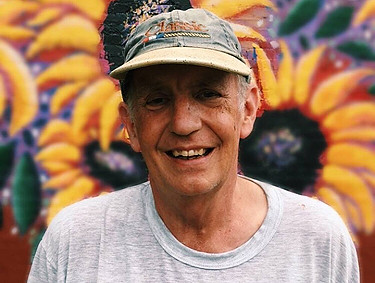
The author in front of a mural painted by our students.
Photo by Madeline Maas.
Making Early Learning Joyful Again
[click to read]
By Valerie Strauss
Back in 2014, I wrote about a New York school that canceled its annual year-end kindergarten show because — are you ready? — the kids had to keep working so they would be ready for “college and career.” If you think that was a singular event, guess again. Preschool and kindergarten have become increasingly academic for years, often to the exclusion of structured play-based learning that has long been seen by experts as being the best way for young children to be educated. Things have gotten to such a point that children who leave kindergarten without having learned to read are often considered failures. (read more)
